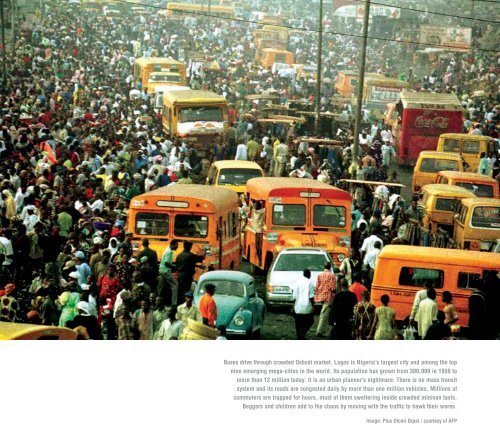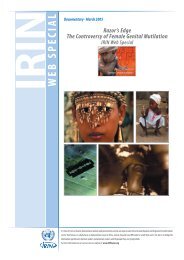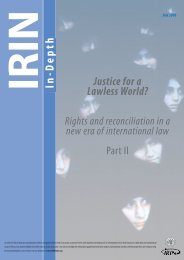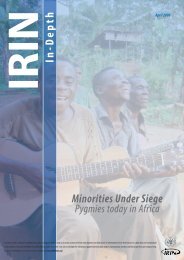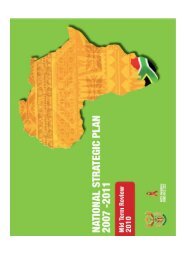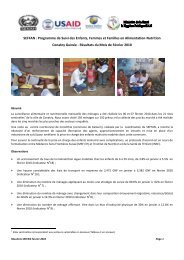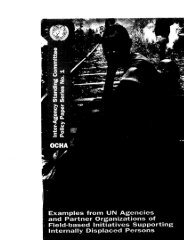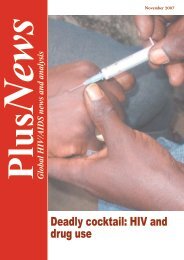Buses drive through crowded Oshodi market. Lagos is ... - IRIN
Buses drive through crowded Oshodi market. Lagos is ... - IRIN
Buses drive through crowded Oshodi market. Lagos is ... - IRIN
You also want an ePaper? Increase the reach of your titles
YUMPU automatically turns print PDFs into web optimized ePapers that Google loves.
<strong>Buses</strong> <strong>drive</strong> <strong>through</strong> <strong>crowded</strong> <strong>Oshodi</strong> <strong>market</strong>. <strong>Lagos</strong> <strong>is</strong> Nigeria’s largest city and among the top<br />
nine emerging mega-cities in the world. Its population has grown from 300,000 in 1950 to<br />
more than 12 million today. It <strong>is</strong> an urban planner’s nightmare: There <strong>is</strong> no mass transit<br />
system and its roads are congested daily by more than one million vehicles. Millions of<br />
commuters are trapped for hours, most of them sweltering inside <strong>crowded</strong> minivan tax<strong>is</strong>.<br />
Beggars and children add to the chaos by moving with the traffic to hawk their wares.<br />
Image: Pius Otomi Ekpei / courtesy of AFP
Chapter 3<br />
governance and planning<br />
lagos: cr<strong>is</strong><strong>is</strong> of management<br />
More than 65 percent of those who migrate to <strong>Lagos</strong> end up living below the national poverty line,<br />
only marginally better than the national average of 70 percent. Migrants usually live in one of the<br />
city’s 200 slums, which range in size from clusters of shacks to entire d<strong>is</strong>tricts. It <strong>is</strong> these people,<br />
currently living in wretched conditions, who suffer more if governments are unable or unwilling<br />
to put human and financial resources into planning for the future and improving governance.<br />
Since 2000, the mega-city of <strong>Lagos</strong> has been drawing in an estimated<br />
600,000 people per year, most of whom end up in slums. As in many<br />
fast-growing cities, the proliferation of slums and the influx of so<br />
many people has put a tremendous strain on the government’s ability<br />
to provide basic services. A combination of difficult terrain and many<br />
years of economic cr<strong>is</strong><strong>is</strong>, m<strong>is</strong>rule and corruption 1 have turned <strong>Lagos</strong><br />
into a governance nightmare.<br />
There <strong>is</strong> no mass transit system, and millions of commuters are<br />
trapped for hours, most of them sweltering inside <strong>crowded</strong><br />
minivan tax<strong>is</strong>. Beggars and children move <strong>through</strong> the traffic,<br />
hawking water, electronic gadgets, medicines, food, clothes, toys,<br />
music cassettes, sunglasses, pens, shoes and picture frames. There <strong>is</strong><br />
no proper sewage network, and safe drinking water <strong>is</strong> available only<br />
to a small number of people. A regular power supply has been<br />
described as a ’d<strong>is</strong>tant dream’, and in heavy rains many homes are<br />
flooded.<br />
“<strong>Lagos</strong> <strong>is</strong> one of those places where you wonder just how anything<br />
manages to function,” said one BBC correspondent, echoing the view<br />
of many who v<strong>is</strong>it or live in Nigeria’s capital.<br />
City governance impacts inhabitants, especially the urban poor, in a<br />
way that does not compare with more self-sufficient and remote rural<br />
areas. Indeed, almost all aspects of urban development – employment<br />
and job creation; public transport and traffic; solid-waste collection<br />
and d<strong>is</strong>posal; water and sanitation; health services; shelter and housing<br />
– hinge on the <strong>is</strong>sue of governance.<br />
l a g o s : c r i s i s o f m a n a g e m e n t 29
In <strong>Lagos</strong>, city management <strong>is</strong> comprom<strong>is</strong>ed by the influence of informal<br />
relationships. “Land rights, employment, industry and other sources of<br />
wealth rely on political interaction, involving patron-client relations,<br />
bribery, corruption, nepot<strong>is</strong>m and/or ’long-legs’ (contacts). Almost<br />
everyone knows someone with a link, however tenuous, to power [...]<br />
There <strong>is</strong> considerable interaction (some would say interference) between<br />
leaders at national, state and local levels and at least some sectors of the<br />
general public...” 2<br />
These informal relationships give r<strong>is</strong>e to social inequity, ethnic tensions<br />
and political instability. Without effective government the entire<br />
concept of rights d<strong>is</strong>appears. “[Unless] concerted action <strong>is</strong> taken to<br />
redress urban inequalities, cities may well become the predominant sites<br />
of deprivation, social exclusion and instability worldwide,” according to<br />
UN-HABITAT. 3 Many argue that <strong>Lagos</strong> has already reached th<strong>is</strong> state.<br />
Its future – and the lives of millions of its residents – depends on<br />
sustainable urban<strong>is</strong>ation and poverty reduction. Good governance <strong>is</strong><br />
fundamental to th<strong>is</strong> task.<br />
<strong>Lagos</strong>: the fastest growing mega-city in the world<br />
<strong>Lagos</strong> <strong>is</strong> the largest city in Nigeria. It <strong>is</strong> the main city of <strong>Lagos</strong> State<br />
and Nigeria’s main commercial centre, with more than 70 percent of<br />
the nation’s industries and economic activities carried out there. The<br />
city <strong>is</strong> also important to the rest of West Africa as a leading regional<br />
port and manufacturing centre with the highest number of<br />
multinational companies.<br />
Worldwide, <strong>Lagos</strong> features among the top nine emerging mega-cities,<br />
including Delhi, Dhaka, Jakarta, Mexico City,<br />
Mumbai, New York, São Paulo and Tokyo. Its<br />
population has grown from 300,000 in 1950 to<br />
more than 12 million today. With an annual<br />
population growth rate of 4.8 percent, it <strong>is</strong><br />
estimated that <strong>Lagos</strong> will be inhabited by more<br />
than 20 million people by 2020 and thereby join the ranks of a growing<br />
number of “hyper-cities”.<br />
Confined to only 3,345sqkm, <strong>Lagos</strong> covers just 0.4 percent of Nigeria’s<br />
entire land area, making it the smallest of the country’s 36 states.<br />
However, it has the greatest number of inhabitants, representing 10<br />
percent of the country’s population.<br />
More than 65 percent of those who migrate to <strong>Lagos</strong> end up living below<br />
the national poverty line, only marginally better off than the national<br />
average of 70 percent. Migrants usually live in one of the city’s 200 slums,<br />
which range in size from clusters of shacks to entire d<strong>is</strong>tricts. It <strong>is</strong> these<br />
people, currently living in wretched conditions, who suffer more if<br />
governments are unable or unwilling to put human and financial resources<br />
into planning for the future and improving governance. The lives of the<br />
urban poor are in the hands of city authorities to a far greater degree than<br />
their rural counterparts, because when deficiencies ex<strong>is</strong>t in urban areas,<br />
there are few independent and appropriate alternatives available to people.<br />
Transportation<br />
People in <strong>Lagos</strong> depend on private cars, buses and tax<strong>is</strong> to get around.<br />
Every day, some one million vehicles congest approximately 2,600km of<br />
roads. “<strong>Lagos</strong> <strong>is</strong> unbearable! People are living in traffic!” exclaimed one<br />
desperate inhabitant in a recent Internet posting.<br />
In a 2005 study by the <strong>Lagos</strong> Metropolitan Transport Authority<br />
(LAMATA), the main instrument for transforming the state transport<br />
system, road traffic was identified as the main source of air pollution in<br />
<strong>Lagos</strong> State, having “catastrophic” health implications. 4<br />
The concentration of carbon monoxide and sulphur dioxide in the air<br />
acts as an irritant to those suffering from lung d<strong>is</strong>eases and can cause<br />
fatigue, loss of v<strong>is</strong>ion, headaches and nausea. “We can safely conclude<br />
that the cost of pollution in metropolitan <strong>Lagos</strong> has increased medical<br />
costs such as medicines and hospital v<strong>is</strong>its and on productivity losses,”<br />
the study found. 5<br />
More than 65 percent of those who migrate to <strong>Lagos</strong> end up living<br />
below the national poverty line, only marginally better off than<br />
the national average of 70 percent.<br />
In addition to posing a health threat, public transport deficiencies<br />
further impover<strong>is</strong>h the urban poor: LAMATA estimates that<br />
transportation costs account for 20 percent of household budgets,<br />
second only to food. 6<br />
The problem with infrastructure <strong>is</strong> nothing new. In <strong>Lagos</strong>, “the colonial<br />
state apparatus and its post-colonial successors never succeeded in<br />
30 l a g o s : c r i s i s o f m a n a g e m e n t
Women carrying household necessities over a bridge in one of <strong>Lagos</strong>, Nigeria’s 200 slums, which range in size from clusters<br />
of shacks to entire d<strong>is</strong>tricts. In <strong>Lagos</strong> – a region of mangrove swamp, rivers and lagoons – water covers more than 40 percent<br />
of the entire area. Still, the majority of slum dwellers do not have access to clean water. Another great challenge facing the<br />
<strong>Lagos</strong> planners <strong>is</strong> housing and shelter since most available land <strong>is</strong> frequently taken over in uncontrolled and unplanned<br />
developments. The urban poor live in wretched conditions and are likely to continue in hardship if governments are unable<br />
or unwilling to put resources into planning for their future as part of an ‘inclusive’ city.<br />
Image: Lionel Healing / courtesy of AFP
When planning for the delivery of basic services<br />
to slum dwellers, cities and utility companies<br />
must take into account the huge number of<br />
households and businesses who gain free access<br />
illegally. In Delhi, India, so many people tap into<br />
otherw<strong>is</strong>e legitimate electrical lines that little or<br />
no effort <strong>is</strong> made to hide it. When an inspector of<br />
a local power company cuts power, it <strong>is</strong> only a<br />
temporary delay. Shortly after the inspector’s<br />
departure, the lines are hooked up again.<br />
Image: Chr<strong>is</strong> Horwood / <strong>IRIN</strong><br />
In <strong>Lagos</strong>, Nigeria, money that might have been<br />
invested in healthcare, housing or physical<br />
infrastructure were allegedly diverted. Now, the<br />
city must find new solutions to old problems: air<br />
pollution caused by road traffic has severe health<br />
implications, particularly for the urban poor who<br />
cannot afford healthcare.<br />
Image: Stuart Franklin / Magnum
uilding a fully functional metropol<strong>is</strong> <strong>through</strong> investment in the built<br />
environment or the construction […] Vast quantities of capital that<br />
might have been invested in health care, housing or physical<br />
infrastructure were either consumed by political and military elites or<br />
transferred to overseas bank accounts with the connivance of Western<br />
financial institutions.” 7<br />
In addition to corruption and lack of political will, poor governance<br />
<strong>is</strong> a major obstacle to transport agencies in developing cities. The<br />
fragmentation and duplication of institutional responsibilities and<br />
In addition to corruption and lack of political will, poor governance <strong>is</strong> a<br />
major obstacle to transport agencies in developing cities.<br />
lack of coordination among agencies and min<strong>is</strong>tries compounds the<br />
problem: In <strong>Lagos</strong>, for example, at least three agencies in addition<br />
to LAMATA are responsible for traffic and transport <strong>is</strong>sues at the<br />
state level. 8<br />
Environmental sanitation<br />
<strong>Lagos</strong> has often been referred to as the one of the dirtiest cities in<br />
the world.<br />
The capital city lacks an effective refuse-collection service and has no<br />
central system for treating sewage and industrial effluent. Filling the<br />
vacuum are self-employed collectors who push carts <strong>through</strong> the streets,<br />
collecting rubb<strong>is</strong>h from residents for a fee. Similarly, private operators<br />
evacuate sewage for city residents. Of some 6,000 tons of waste<br />
generated daily, only 3,000 tons are taken to three official dump sites by<br />
government-appointed refuse collectors and informal collectors,<br />
according to the World Bank.<br />
<strong>Lagos</strong> health and environment officials acknowledge that most of the<br />
rubb<strong>is</strong>h and sewage collected by private operators, as well as the<br />
industrial effluent, ends up in the lagoons and creeks. Much of the<br />
rest <strong>is</strong> burned in illegal rubb<strong>is</strong>h dumps or in one of three official<br />
dumping sites.<br />
Untreated sewage pollutes the lagoon and destroys marine and aquatic<br />
life, said Kenneth Iwugo, a Nigerian marine scient<strong>is</strong>t affiliated with the<br />
University of Br<strong>is</strong>tol who studied water pollution in <strong>Lagos</strong>. Where<br />
rubb<strong>is</strong>h and other solid waste are dumped in officially appointed<br />
landfills, contaminants leak into ground and surface water, he said.<br />
In Makoko slum, residents use small enclosures attached to their shelters<br />
as toilets and bathrooms. All waste <strong>is</strong> dumped into the same lagoon<br />
where they f<strong>is</strong>h. There are pit toilets in areas of the settlement lying on<br />
firmer ground, but each one serves several families.<br />
<strong>Lagos</strong> <strong>is</strong> particularly susceptible to water pollution because the water<br />
table <strong>is</strong> very shallow, sometimes only<br />
three metres from the surface, Iwugo<br />
said. In addition, the relatively loose<br />
and easily permeable soil allows the<br />
infiltration of contaminants. These<br />
environmental factors affect the food source and pose a significant r<strong>is</strong>k<br />
of viral and bacterial d<strong>is</strong>eases such as polio, meningit<strong>is</strong>, diarrhoea,<br />
cholera, parasitic infection and fevers spread by waterborne vectors.<br />
Shelter and housing<br />
Another great challenge <strong>is</strong> housing and shelter, particularly for people<br />
living in over<strong>crowded</strong> slums. Official estimates put the population<br />
density of metropolitan <strong>Lagos</strong> at 1,308 per square kilometre, but in<br />
heavily built-up areas the average density reaches 20,000 per square<br />
kilometre.<br />
The housing demand <strong>is</strong> unparalleled in any other part of Nigeria, and<br />
most available land in <strong>Lagos</strong> falls prey to unregulated and unplanned<br />
development. According to a 1978 law, all land in Nigeria <strong>is</strong> vested in<br />
the government. 9 However, traditional land rights are also recogn<strong>is</strong>ed,<br />
which often leads to conflicting tenure claims and d<strong>is</strong>putes. Insecure<br />
land tenure has helped spawn the many slums occupied by squatters,<br />
who, without a legal title to land, are unable to take out mortgages.<br />
Housing in the illegal slums <strong>is</strong> rent-free, but the trade-off <strong>is</strong> insecurity<br />
and poor or no amenities.<br />
Informal settlements are absolutely off the radar in terms of<br />
infrastructure, services and future planning, except perhaps in terms of<br />
planning to remove them. In the name of security or economic<br />
development, a succession of governments has resorted to demolition as<br />
a solution to slum proliferation. These forced evictions make hundreds<br />
l a g o s : c r i s i s o f m a n a g e m e n t 33
of thousands of urban poor destitute overnight, as they immediately<br />
decamp to another, probably more marginal and inappropriate piece<br />
of land.<br />
By the beginning of the 1990s, the most well-known slum in <strong>Lagos</strong> was<br />
Maroko, where some one million people lived in makeshift squalor<br />
next to the residential d<strong>is</strong>trict of Victoria Island. In 1991 Raji Rasaki,<br />
then-military governor of <strong>Lagos</strong>, gave Maroko residents two weeks to<br />
move and, when the deadline passed, promptly sent in bulldozers to<br />
demol<strong>is</strong>h the shantytown, ignoring a public<br />
outcry. None of the residents were resettled or<br />
compensated. Illustrating the common trend of<br />
’spatial exclusion‘ – where the urban poor are<br />
<strong>drive</strong>n out of town centres, allowing real estate<br />
values to soar – the area has since been taken over by wealthier<br />
residential developments and shopping malls, all of which are wellprovided<br />
with basic services.<br />
Following th<strong>is</strong> precedent, demolition has become a frequent recourse for<br />
local authorities, who are often beholden to land speculators keen to<br />
cash in on the acute land scarcity of <strong>Lagos</strong>. In the past two years, parts<br />
of the Ijora-Badiya and Makoko slums also fell to bulldozers.<br />
According to a joint study by Tunde Agbola and Elijah Agunbiade (two<br />
Nigerian researchers linked respectively to the University of Ibadan,<br />
Nigeria, and the University of <strong>Lagos</strong>), summary state-implemented<br />
evictions are unlikely to amount to any lasting solution. They call for “a<br />
v<strong>is</strong>ion of how to regular<strong>is</strong>e the city’s informal settlements and develop an<br />
inclusive city for all its citizens.”<br />
In an attempt to address the cr<strong>is</strong><strong>is</strong> of urban<strong>is</strong>ation in <strong>Lagos</strong> State, authorities<br />
have launched a <strong>Lagos</strong> Metropolitan Development and Governance<br />
Project backed with a US$200 million World Bank loan approved in March<br />
2006. The World Bank currently has 22 active projects in Nigeria with a<br />
total commitment value of $2.2 billion, and the governance project <strong>is</strong> one<br />
of the highest valued active projects. 10 According to Deepali Tewari, the<br />
bank’s senior municipal development special<strong>is</strong>t overseeing the project, the<br />
“objective <strong>is</strong> to increase sustainable access to basic urban services <strong>through</strong><br />
investments in critical infrastructure.”<br />
Good governance <strong>is</strong> the essential first step towards alleviating<br />
poverty in the <strong>crowded</strong> slums of <strong>Lagos</strong>.<br />
Under th<strong>is</strong> initiative, nine of the biggest slums in <strong>Lagos</strong> will be rebuilt;<br />
the city’s drainage system will be reconstructed to provide a long-term<br />
solution to perennial flooding; and infrastructure will be upgraded for<br />
the management of solid waste. Funding will also be devoted to<br />
improving public governance and the institutional capacity to identify<br />
and priorit<strong>is</strong>e the most pressing needs of the city.<br />
Good governance <strong>is</strong> the essential first step towards alleviating poverty in<br />
the <strong>crowded</strong> slums of <strong>Lagos</strong>. Years of economic cr<strong>is</strong><strong>is</strong>, corruption, the<br />
fragmentation and duplication of responsibilities, and the intrusion of<br />
informal relationships into the government’s work have conspired to<br />
make daily life a m<strong>is</strong>ery for the burgeoning number of urban poor in<br />
<strong>Lagos</strong>. Even with adequate funding, sustainable improvement will be<br />
impossible without the political will to abandon corrupt practices and<br />
institute careful, appropriate planning.<br />
34 l a g o s : c r i s i s o f m a n a g e m e n t
Above: Shibam, Yemen – the ‘Manhattan of the<br />
desert’ in Yemen started 2000 years ago. Below:<br />
Mexcalitán in Mexico, said by some to be the<br />
birthplace of the Aztecs. Urban settlements are<br />
neither new nor are they destined to be chaotic<br />
centres of deprivation. The key <strong>is</strong>sues are<br />
management, good governance and planning<br />
underwritten by political will.<br />
Images: © Yann Arthus-Bertrand / Earth from Above<br />
(www.yannarthusbertrand.org / www.goodplanet.org)
Tensions run deep as policemen break up<br />
a demonstration by residents of Mathare<br />
slum in Nairobi, Kenya, on 31 July 2007. The<br />
demonstrations were organ<strong>is</strong>ed after authorities<br />
d<strong>is</strong>connected an illegally connected water source,<br />
which left slum dwellers without water for a few<br />
days. Around the world, the majority of people<br />
living in slums have no access to basic services.<br />
Water and electricity are particularly hot<br />
commodities, compelling people to illegally<br />
tap sources. Although the demand for basic<br />
services <strong>is</strong> a legitimate one, city officials must<br />
navigate a path <strong>through</strong> legitimate demands<br />
and illegality.<br />
Image: Julius Mwelu / <strong>IRIN</strong>


